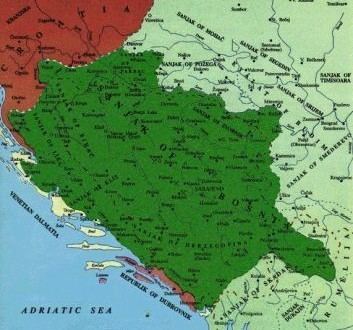1580–1867 → → Disestablished 1867 | Established 1580 1732 340,000 | |
 | ||
Capital Bosna-Saray (now Sarajevo)(1520–1553)Banja Luka(1553–1639)Bosna-Saray (now Sarajevo)(1639–1699)Travnik(1699–1832) 1856 70,038 km (27,042 sq mi) | ||
Bosnia eyalet
The Eyalet of Bosnia (Ottoman Turkish: eyalet-i Bosna, Bosnian: Bosanski pašaluk) or Bosnia Beylerbeylik (Turkish: Bosna Beylerbeyliği, Bosnian: Bosanski beglerbegluk) was an Eyalet (also known as a beylerbeylik) of the Ottoman Empire, mostly based on the territory of the present-day state of Bosnia and Herzegovina. Prior to the Great Turkish War, it had also included most of Slavonia, Lika, and Dalmatia in present-day Croatia. Its reported area in the 19th century was 20,281 square miles (52,530 km2).
Contents
Background
After the execution of King Stephen Tomašević in 1463, the central part of the Kingdom of Bosnia was transformed into the sanjak of Bosnia. The Duchy of Herzegovina was added in 1483.
Establishment
In 1580, Ferhad pasha Sokolović became the first governor of the Bosnia Eyalet, as beylerbey (also referred to as "pasha"). The Bosnia Eyalet (or Pashaluk) included the Sanjak of Bosnia (central province), Sanjak of Herzegovina, Sanjak of Vučitrn, Sanjak of Prizren, Sanjak of Klis, Sanjak of Krka, and Sanjak of Pakrac.
The Ottoman wars in Europe continued throughout the period, and the province reached its territorial peak in 1683.
Decline
The Great Turkish War that ended in Ottoman defeat in 1699 led to a significant decrease in the territory of the Eyalet. After the Treaty of Karlowitz, the province was down to four sanjaks (three of them diminished in size as well) and twelve captaincies. Before the Treaty of Passarowitz, another 28 military captaincies were formed, more than half of them along the frontier. This kind of intensive military administration corresponded to the Austrian Military Frontier on the other side of the same border. In 1703 the seat of the pasha was moved from Sarajevo to Travnik, because Sarajevo had been destroyed by fire in the war; it wouldn't be moved back until 1850.
Bosnian uprising
At the beginning of the 19th century, Bosnia was one of the least developed and more autonomous provinces of the Empire. In 1831, Bosnian kapudan Husein Gradaščević occupied Travnik, demanding autonomy and the end of military reforms in Bosnia. Ultimately, exploiting the rivalries between beys and kapudans, the grand vizier succeeded in detaching the Herzegovinian forces, led by Ali-paša Rizvanbegović, from Gradaščević’s. The revolt was crushed, and in 1833, a new eyalet of Herzegovina was created from the southern part of the eyalet of Bosnia and given to Ali-paša Rizvanbegović as a reward for his contribution in crushing the uprising. This new entity lasted only for a few years: after Rizvanbegović's death, it was reintegrated into the Bosnia eyalet.
It was one of the first Ottoman provinces to become a vilayet after an administrative reform in 1865, and by 1867 it had been reformed into the Bosnia Vilayet.
Governors
Capitals
Bosnia Eyalet's capital city moved several times:
